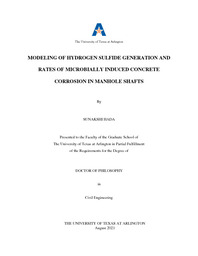| dc.description.abstract | Manhole shafts can undergo infrastructure failure due to microbially induced concrete corrosion (MICC). Deterioration of the sewer systems by MICC process occurs due to the volatilization of hydrogen sulfide into the gas phase. The volatized hydrogen sulfide gas reacts with oxygen to form sulfuric acid, resulting in concrete corrosion. If optimum conditions are present, 24 mm of concrete loss can occur in 31 months, and the cost of fixing can range from $10-$30 per square foot. Also, if the manholes are not properly maintained, they can cause serious safety hazards, such as manhole lids falling through the structure, streets giving way, or sewers flowing beyond their capacity.
The project aimed to identify and predict factors contributing to corrosion in the unsubmerged sections of the manholes. Wastewater characteristics and sewer system designs affect sulfide generation, volatilization, and corrosion of concrete manholes. Since various factors contribute towards the MICC process, the initial phase of the project involved data collection of liquid and gas phase parameters and measuring depth of corrosion. The second stage of the project involved developing models to predict gas-phase hydrogen sulfide concentrations and corrosion rates.
Based on their physical design, 366 manholes in the City of Arlington were selected for the study. Since physical design of the manhole determines the rates of corrosion, the various design criteria considered for manhole selection were presence of drop, pipe size changes, type of flows, presence of bends, and number of inlets. Field studies were conducted with 48 hours of continuous data collection of gas-phase parameters, including temperature, hydrogen sulfide concentrations, relative humidity, oxygen concentration, and liquid phase parameters including temperature, dissolved oxygen, pH, sulfide, sulfate, and biochemical oxygen demand. The collected data was then used to build predictive models using multiple linear regression. A preliminary model was developed to address concerns with normality or nonconstant variance and carried out necessary transformations. Possible interactions were identified based on literature and added to the transformed model. Best subset and stepwise method were adopted to identify best possible model using Cp value, variance inflation factor, Adjusted R2, AIC, BIC, and p-value. Detailed analysis utilizing model diagnostics (modified Levene’s test, normality test, and outlier test), and model validation using the test set was conducted to identify the best possible model.
Plots of data collected showed manholes with hydraulic jump or downstream of a lift station recorded highest hydrogen sulfide concentration in comparison to the other manhole types, and the lowest was observed in manholes with subcritical flow. In addition, for manholes studied for seasonal variation, the concentration of hydrogen sulfide was found to be maximum during the summer, when the temperature was elevated, and less during fall and winter.
The multiple linear regression model for hydrogen sulfide had predictor variables (significant at alpha= 0.1) of velocity, presence of hydraulic jump, precipitation, pH, manhole design with inlet smaller in diameter than outlet pipe, straight flow, location of manhole upstream to a high hydrogen sulfide manhole, and the interaction of sulfate with dissolved oxygen and supercritical flow with dissolved oxygen (R-square=0.36). High velocities, hydraulic jump, and supercritical flow will generate turbulence, which transfers hydrogen sulfide from the liquid to gas phase. Precipitation lowers of ambient temperatures, which reduces hydrogen sulfide volatilization according to Henry’s law.
The multiple linear regression model for corrosion had predictor variables (significant at alpha= 0.1) of manhole age, presence of right angle, presence of multiple inlets, BOD concentration and interaction between manhole age with gas phase temperature (R-square=0.35). The corrosion model association with the age of the manhole is important: concrete characteristics change with age, thus effecting hydrogen sulfide diffusion into the concrete. | |


